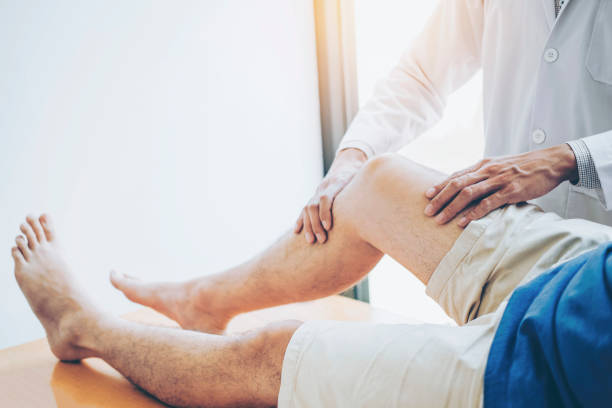The knee is a complex joint crucial for mobility, bearing significant weight and facilitating movement. Unfortunately, knee injuries are all too common, affecting people of all ages and activity levels. Whether caused by sports, accidents, or degenerative conditions, these injuries can be debilitating if not properly addressed. In this comprehensive guide, we’ll explore some of the most common knee injuries, their causes, symptoms, diagnostic methods, and treatment options.
Before delving into specific injuries, it’s essential to understand the structure and function of the knee joint. The knee is the largest joint in the body, comprising bones, cartilage, ligaments, tendons, and fluid-filled sacs called bursae. The knee joint allows for flexion, extension, and some rotation, enabling activities such as walking, running, and jumping.
Common Knee Injuries:
- Anterior Cruciate Ligament (ACL) Tear:
- Causes: ACL tears often occur during sports that involve sudden stops, changes in direction, or direct impact, such as soccer, basketball, or skiing. They can also result from non-contact injuries, such as pivoting or landing awkwardly.
- Symptoms: Symptoms include a popping sensation at the time of injury, swelling, instability, and difficulty bearing weight.
- Diagnosis: Diagnosis is typically made through a physical examination, imaging tests such as MRI, and sometimes arthroscopy.
- Treatment: Treatment may involve rest, physical therapy, bracing, or surgical reconstruction, depending on the severity of the tear and the patient’s activity level.
- Meniscus Tear:
- Causes: Meniscus tears often result from twisting the knee while bearing weight, common in sports like football, tennis, or gymnastics. They can also occur due to degenerative changes in older adults.
- Symptoms: Symptoms include pain, swelling, stiffness, catching or locking of the knee, and limited range of motion.
- Diagnosis: Diagnosis is made through a physical examination, imaging tests, such as MRI, and sometimes arthroscopy.
- Treatment: Treatment options include rest, ice, physical therapy, and in some cases, arthroscopic surgery to repair or remove the torn portion of the meniscus.
- Patellar Tendonitis (Jumper’s Knee):
- Causes: Patellar tendonitis is an overuse injury commonly seen in athletes whose sports involve repetitive jumping, such as basketball or volleyball.
- Symptoms: Symptoms include pain and tenderness around the patellar tendon, especially during activities that involve jumping or squatting.
- Diagnosis: Diagnosis is based on a physical examination, medical history, and imaging tests like ultrasound or MRI.
- Treatment: Treatment typically involves rest, ice, anti-inflammatory medications, physical therapy, and modifying activities to reduce strain on the tendon.
- Patellofemoral Pain Syndrome:
- Causes: This syndrome results from imbalances in the forces controlling the patella’s movement, often due to muscle weakness, tightness, or poor biomechanics.
- Symptoms: Symptoms include pain behind or around the kneecap, especially with activities like climbing stairs, kneeling, or sitting for prolonged periods.
- Diagnosis: Diagnosis is made based on symptoms, physical examination findings, and ruling out other potential causes of knee pain.
- Treatment: Treatment may involve rest, ice, physical therapy to strengthen muscles and improve biomechanics, bracing, and modifying activities to alleviate stress on the knee.
- Knee Bursitis:
- Causes: Knee bursitis occurs when the bursae, small fluid-filled sacs that cushion the knee joint, become inflamed due to repetitive pressure or trauma.
- Symptoms: Symptoms include pain, swelling, and tenderness around the knee, often worsened with kneeling or bending.
- Diagnosis: Diagnosis is typically based on a physical examination and sometimes imaging tests like ultrasound or MRI.
- Treatment: Treatment involves rest, ice, anti-inflammatory medications, aspiration of excess fluid from the bursa, and addressing the underlying cause of inflammation.
- Ligament Sprains:
- Causes: Ligament sprains can occur when the knee is twisted or hyperextended beyond its normal range of motion, resulting in stretching or tearing of the ligaments.
- Symptoms: Symptoms vary depending on the severity of the sprain but may include pain, swelling, instability, and difficulty bearing weight.
- Diagnosis: Diagnosis is made through a physical examination, imaging tests, such as MRI, and sometimes arthroscopy.
- Treatment: Treatment may involve rest, ice, compression, bracing, physical therapy, and in severe cases, surgical repair.
- Osteoarthritis:
- Causes: Osteoarthritis is a degenerative joint disease characterized by the breakdown of cartilage in the knee joint, leading to pain, stiffness, and reduced mobility.
- Symptoms: Symptoms include pain, stiffness, swelling, and a grating sensation when moving the knee.
- Diagnosis: Diagnosis is based on symptoms, physical examination findings, and imaging tests such as X-rays or MRI.
- Treatment: Treatment focuses on managing symptoms through weight management, exercise, pain medications, physical therapy, injections (e.g., corticosteroids or hyaluronic acid), and in severe cases, joint replacement surgery.
Knee injuries are prevalent and can significantly impact an individual’s quality of life, mobility, and ability to participate in activities they enjoy. Early recognition, accurate diagnosis, and appropriate treatment are crucial for optimizing outcomes and preventing long-term complications. By understanding the common knee injuries discussed in this guide and their respective treatment approaches, individuals can take proactive steps to protect their knee health and minimize the risk of injury recurrence. As always, consulting with a healthcare professional for personalized assessment and guidance is recommended for anyone experiencing knee pain or injury symptoms.

